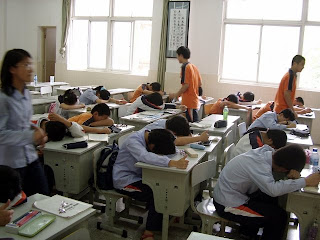Below are two specific examples of instances phys ed class being improperly planned, and not relating to the curriculum.
1 - A grade 5/6 teacher had 30 minutes of phys ed scheduled right after lunch. The students came in from lunch and did not get settled quickly so she told them they were wasting gym time and they would not go until everyone was quiet and in their desks. This is a valid classroom management technique, but it caused 10 minutes of time to pass before everyone was ready. Then, before going to the gym she asked for 3 suggestions of warm up games, and 3 suggestions of main activity games that could be played in the remaining 20 minutes of gym. The class was going to vote on which activity to do for warm up, and which one to do as the main activity. The suggestions were all things like line tag, dodgeball, and kings court. The class then voted and ended up playing line tag as a warm up and dodgeball as the main activity.
 |
| Image from Victoria Morse (some rights reserved) |
In both of these activities once a student was "out" they were sitting on the bench waiting for a new game to begin. These activities were exclusionary in that they did not allow for all students to participate thoroughly. Also, I question where these activities fit within the curriculum.
2 - I was in a grade 7/8 class working with a couple of students on writing when the grade 1/2 teacher came in and asked if she could borrow a student to "teach some basketball drills to her class".
 |
| Image from jbrownell (some rights reserved) |
It's been said on this blog before, but there is a curriculum, and required weekly teaching hours for phys ed as there are for every other subject. It continues to surprise me how often those requirements are tossed aside.

